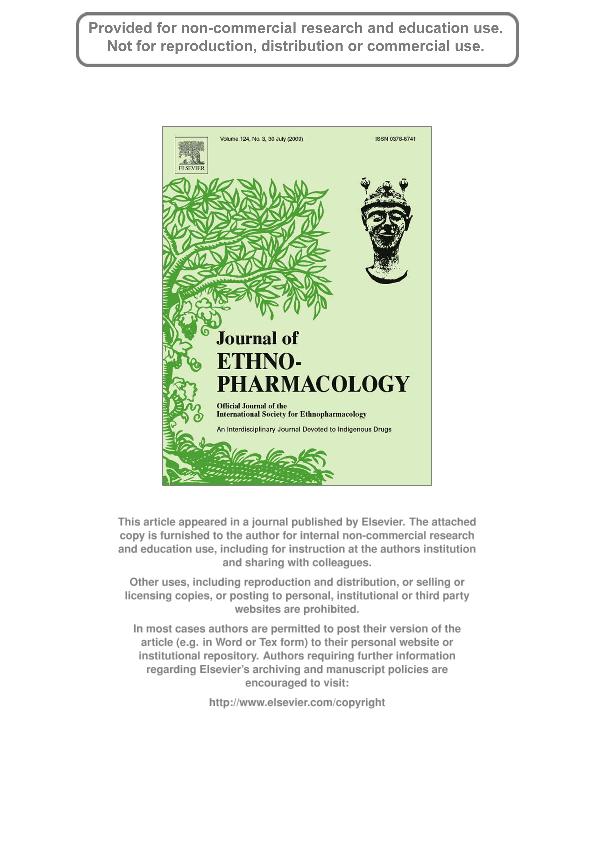Artículo
Influence of plant part, season of collection and content of the main active constituent, on the antifungal properties of Polygonum acuminatum Kunth
Fecha de publicación:
07/2009
Editorial:
Elsevier Ireland
Revista:
Journal of Ethnopharmacology
ISSN:
0378-8741
Idioma:
Inglés
Tipo de recurso:
Artículo publicado
Clasificación temática:
Resumen
Ethnopharmacological relevance: Polygonum acuminatum Kunth. (Polygonaceae) is used to heal infected wounds and as antifungal in the traditional Argentinean medicine. Aim of the study: The present investigation was carried out to evaluate the antifungal properties of aerial parts of Polygonum acuminatum, in order to give support to its ethnopharmacological use as antifungal agent and to isolate the compound(s) responsible for the antifungal properties. The influence of the plant part used, the season of the year and a study of the correlation of the antifungal activity with the content of the main active constituent were investigated too, with the aim of contributing to determine the most suitable plant extract and season of the year for achieving the best antifungal properties for Polygonum acuminatum traditional use. Materials and methods: For the antifungal evaluation, the microbroth dilution assay recommended by the Clinical and Laboratory Standards Institute (CLSI, formerly NCCLS) was used against a panel of human opportunistic and pathogenic fungi. Bioassay-guided fractionation allowed us to isolate the compounds responsible for the antifungal activity. GC-MS was used to quantify the main component in the different extracts. For the statistical analysis, ANOVA test for analyses of variance followed by the Tukey test of Multiple Comparisons were used. The correlations between content of the antifungal compound and antifungal activity, were calculated with the Spearman Correlation Coefficient. Results: Aerial parts (A) of Polygonum acuminatum showed to possess antifungal properties against yeasts as well as dermatophytes but not against Aspergillus spp. From the most active extract (ADCM), polygodial, isopolygodial, drimenol and confertifolin were isolated, possessing polygodial a broader spectrum of action and lower MICs than the rest of compounds. Among the different parts, leaves (L), stems (S) and fruits (F), that constitute the aerial parts of Polygonum acuminatum, (L) showed to possess the best activities, compared to (S) and (F). The analysis of the content of polygodial in the LHex, LDCM, LEtOAC, LMeOH extracts collected in Summer, Autumn, Winter and Spring showed that LDCM of all seasons possessed higher percentages of this sesquiterpene than the rest of extracts. Among the LDCM of different seasons, that of Autumn was the most concentrated in polygodial. The correlation between content of polygodial with antifungal behavior of the different extracts, showed that LDCM of Autumn contains the highest content of polygodial and concomitantly the lowest MICs. Conclusion: The ethnopharmacological use of Polygonum acuminatum aerial parts in the Argentinean traditional medicine for ailments related to fungal infections is supported by the results obtained in this investigation. From the obtained results, LDCM of Autumn, possessing the highest content of polygodial and the lowest MICs, appeared to be the most suitable extract for being used as antifungal in the traditional medicine. Nevertheless, if some other plant collection of another season different from Autumn is available, a LDCM extract would be the better option, because it contains a higher amount of polygodial compared to LHex, LEtOAc or LMeOH and therefore, a better antifungal activity can be expected.
Archivos asociados
Licencia
Identificadores
Colecciones
Articulos(INQUINOA)
Articulos de INST.DE QUIMICA DEL NOROESTE
Articulos de INST.DE QUIMICA DEL NOROESTE
Citación
Derita, Marcos Gabriel; Leiva, M. L.; Zacchino, Susana Alicia Stella; Influence of plant part, season of collection and content of the main active constituent, on the antifungal properties of Polygonum acuminatum Kunth; Elsevier Ireland; Journal of Ethnopharmacology; 124; 3; 7-2009; 377-383
Compartir
Altmétricas




